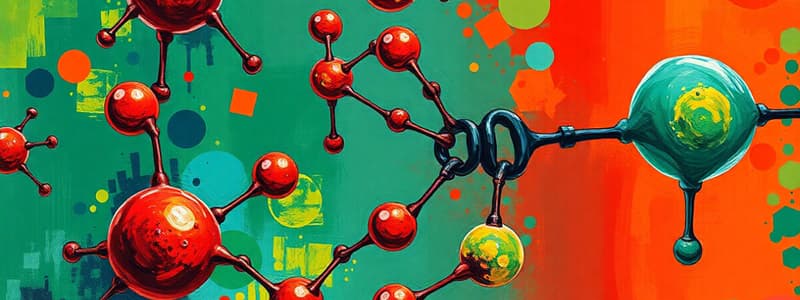Podcast
Questions and Answers
Which type of receptor directly controls the flow of ions?
Which type of receptor directly controls the flow of ions?
- Nuclear receptors
- Ion channel-linked receptors (correct)
- Enzyme-linked receptors
- G protein-coupled receptors (GPCRs)
Agonists bind to receptors and activate them, while antagonists bind to receptors but do not trigger a biological response.
Agonists bind to receptors and activate them, while antagonists bind to receptors but do not trigger a biological response.
True (A)
What is an example of a drug that acts as an agonist to beta-adrenergic receptors?
What is an example of a drug that acts as an agonist to beta-adrenergic receptors?
Salbutamol
Beta blockers like propranolol are examples of __________ that block the effects of adrenaline.
Beta blockers like propranolol are examples of __________ that block the effects of adrenaline.
Match the following drugs to their classifications:
Match the following drugs to their classifications:
What is the primary function of carrier molecules (transporters)?
What is the primary function of carrier molecules (transporters)?
An agonist drug can block the activity of a transporter.
An agonist drug can block the activity of a transporter.
What type of drug is commonly used to block the reuptake of serotonin?
What type of drug is commonly used to block the reuptake of serotonin?
Enzymes act as ______ that speed up chemical reactions in the body.
Enzymes act as ______ that speed up chemical reactions in the body.
Which of the following statements about ion channels is correct?
Which of the following statements about ion channels is correct?
ACE inhibitors act as antagonists to angiotensin-converting enzymes.
ACE inhibitors act as antagonists to angiotensin-converting enzymes.
Calcium channel blockers prevent calcium ions from ______ into smooth muscle cells.
Calcium channel blockers prevent calcium ions from ______ into smooth muscle cells.
Match the following classes of drugs with their actions:
Match the following classes of drugs with their actions:
Flashcards
Carrier Molecules
Carrier Molecules
Proteins that move substances across cell membranes.
Agonist (Carrier Molecules)
Agonist (Carrier Molecules)
Drug that enhances transporter activity, increasing substance movement.
Antagonist (Carrier Molecules)
Antagonist (Carrier Molecules)
Drug that blocks transporter activity, preventing substance movement.
Enzyme
Enzyme
Signup and view all the flashcards
Agonist (Enzymes)
Agonist (Enzymes)
Signup and view all the flashcards
Antagonist (Enzymes)
Antagonist (Enzymes)
Signup and view all the flashcards
Ion Channels
Ion Channels
Signup and view all the flashcards
Antagonist (Ion Channels)
Antagonist (Ion Channels)
Signup and view all the flashcards
Receptors
Receptors
Signup and view all the flashcards
Agonist
Agonist
Signup and view all the flashcards
Antagonist
Antagonist
Signup and view all the flashcards
G protein-coupled receptors (GPCRs)
G protein-coupled receptors (GPCRs)
Signup and view all the flashcards
Ligand-gated ion channel
Ligand-gated ion channel
Signup and view all the flashcards
Study Notes
Drug Target Molecules and Mechanisms
- Carrier Molecules (Transporters): Proteins that move substances across cell membranes, including neurotransmitters, glucose, amino acids, and ions.
- Agonist: Drug that binds to a transporter, enhancing its activity, increasing molecule transport.
- Antagonist: Drug that blocks or inhibits transporter activity, preventing substance movement.
- Example (SSRIs): Block serotonin transporter, preventing serotonin reuptake, increasing serotonin levels.
Enzymes
- Description: Biological catalysts speeding up chemical reactions, involved in metabolism, neurotransmitter breakdown, and hormone regulation.
- Agonist: (Less common) Drugs that enhance enzyme activity.
- Antagonist: (Common) Drugs that inhibit enzymes, reducing molecule production or modifying processes.
- Example (ACE inhibitors): Inhibit angiotensin-converting enzyme, lowering blood pressure.
Ion Channels
- Description: Membrane proteins allowing ions (e.g., sodium, potassium, calcium) to pass into or out of cells, critical for nerve transmission, muscle contraction, and homeostasis.
- Agonist: Drug that increases ion channel activity, allowing more ion flow.
- Antagonist: Drug that blocks or inhibits ion channels, preventing ion flow.
- Example (Calcium Channel Blockers): Block calcium ion flow into smooth muscle cells, leading to vasodilation (widening of blood vessels).
Receptors
- Description: Proteins on or inside cells that bind to specific molecules (ligands) like hormones, neurotransmitters, or drugs, mediating biological effects.
- Types:
- G protein-coupled receptors (GPCRs): Involved in neurotransmitter and hormone signaling.
- Ion channel-linked receptors: Directly control ion flow.
- Nuclear receptors: Found inside cells, regulate gene expression interacting with hormones.
- Agonist: Drug binding to a receptor, activating it; mimicking natural ligand to trigger a response.
- Antagonist: Drug binding to a receptor but not activating it, blocking receptor, preventing endogenous ligand/agonist binding.
- Example (Beta-adrenergic Receptors):
- Agonist (Salbutamol): Causes bronchodilation (widening of airways), treating asthma.
- Antagonist (Propranolol): Blocks adrenaline effects, reducing heart rate and blood pressure.
Agonist vs. Antagonist
- Agonist: Molecule activating a receptor, ion channel, enzyme, or transporter, producing a biological response.
- Antagonist: Molecule binding, but not activating target; blocking natural ligand or agonist action.
Studying That Suits You
Use AI to generate personalized quizzes and flashcards to suit your learning preferences.




